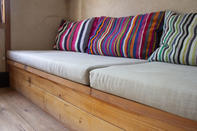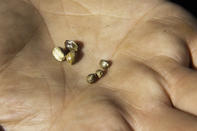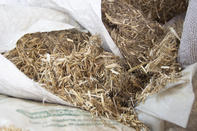An ancient crop used for millennia before it was banned by modern Western civilisation in the 1930s, the hemp plant’s fibres and oil have been integral to humankind’s development.

Hemp as Textile
Textiles from hemp fibres have been used in the making of soldier’s uniforms, sails and ropes for the ships of early seafaring explorers, flags and books in newly established colonies as well as the clothes of early mineworkers.
The nutritious hemp oil is used in foods, skincare and cosmetics, and CBD-containing hemp oil has many medicinal applications. Hemp is also planted to extract toxins from the soil, as part of crop rotation systems to improve soil health and to manufacture biofuels.
The biggest use of hemp is for CBD hemp oil (23%), then personal care products (22%) followed by industrial use (18%).
The long, strong outer fibres of the hemp stalk are used to make fabric and textiles.
As reflected by the USA National Hemp Association, the hemp plant has the strongest and longest plant fibre in the world and was used long before nylon was patented in 1937. Hemp is resistant to rotting and wear-and-tear. It was used for ship rigging, military uniforms, parachute webbing, baggage, and ropes.
The original Levi jeans were primarily made from hemp sailcloth for gold miners in California. In the years during the Second World War, the US army encouraged American farmers to plant hemp for the production of rope and textiles which could not be imported due to the war. Later, when the war ended, all permits for growing hemp were cancelled.
Hemp fabric is three times stronger than cotton and can be blended with silk and cotton to yield fabrics of different textures.
Hemp Paper
Hemp paper does not yellow with age, it is stronger than wood-based paper and can tolerate more folding. In addition, using hemp for paper is more sustainable than wood fibre as it grows to maturity within four months. Which is much quicker than trees.
Hemp in Cars
In 1941, Henry Ford, founder of the Ford Motor Company, developed a car powered by hemp and other plant-based fuels, as well as bumpers made of hemp and other materials. In 2019, motor manufacturer Porsche released the 718 Cayman GT4 Clubsport with bodywork constructed from hemp fibres and plastic. Hemp replaced carbon fibre to strengthen the plastic resin.
Hemp for Health
Hemp CBD oil’s medical use is attributed to antioxidants, polyunsaturated fatty acids and cannabinoids present in the oil that is extracted from the flowers, leaves and stems. One of the major cannabinoids, CBD is used for its anti-inflammatory, pain and nausea-reducing effects.
Hemp oil cold-extracted from the seeds is high in poly-unsaturated fatty acids and is used as a salad oil and in cosmetics.
Hemp Foods

Hemp seeds are used in both animal and human food. It is extracted to produce a salad oil. Hemp seed powder (made from the oil’s seed cake after oil extraction) is a protein-rich nutritious flour used in baked goods, smoothies, and snack bars.
Hemp in the Building Industry

Inside the hemp stalk is a thick, chalky substance called hurd. This dense material is used in the building industry. Chopped into fragments, hemp hurd is mixed with a binding agent. This mixture is used to make bricks and sheets - used as an insulative building material.
Industrial hemp oil is a light oil suitable as varnish for use on wood. It can also be used in paints, machine lubricants, and inks. Product test results showed hemp oil outperforming synthetic and petroleum-based polymer products while containing very low levels of toxic and volatile organic compounds.
Hemp Products in South Africa
Hemp products in South Africa are all imported. Textiles are manufactured in China. CBD products are imported from the USA. Nutritional seeds come from Germany. Nutritional hemp seed oil is sourced from Canada, while hemp building materials are from the United Kingdom.
By Marinda Louw